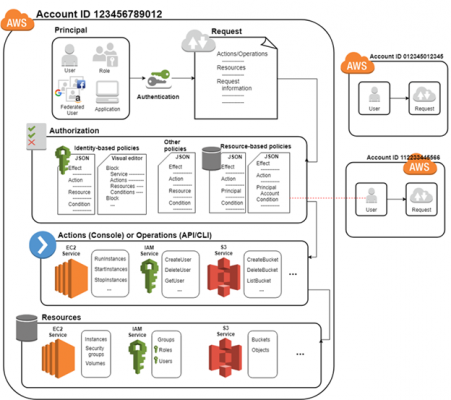- Expands to Identity and Access Management
- IAM provides a one-stop platform for control of AWS account
- It has a global perspective and implementation as users, groups, policies under IAM are accessible across regions and not regional IAM
- SSO can be implemented under Identity Federation by SAML
- Has provision for temporary access
- IAM important terms
- Resources – Objects stored in IAM are resources. They can be added, edited or removed as per need. Resources includes
- User
- Group
- Role
- Policy
- identity provider
- Identities – It is a reference for IAM resources and, applied for identification or grouping of IAM resources. Policy association is needed for IAM identity. Identity includes
- Users
- Groups
- roles
- Entities – IAM resources used for authentication. It includes
- users
- roles – can be assumed by IAM users, in another account or federated by web identity or SAML.
- Principals – Refer to
- Person/application using AWS account as root user
- an IAM user
- IAM role which can sign in or make requests to AWS.
- Resources – Objects stored in IAM are resources. They can be added, edited or removed as per need. Resources includes
- Terms used
- User — an end user (like…a person)
- Groups — refers to set of users linked to a specific permissions
- Policies — a document that defines permissions (which you assign to users, groups, and roles)
- Roles — this has nothing to do with the users in account. Roles are for granting permissions to resources, like an EC2 instance (it can do other cool stuff too)

Default limits for IAM entities:
| Resource | Default Limit |
| Customer managed policies in an AWS account | 1500 |
| Groups in an AWS account | 300 |
| Roles in an AWS account | 1000 |
| Managed policies attached to an IAM role | 10 |
| Managed policies attached to an IAM user | 10 |
| Count of virtual MFA devices whether assigned/unassigned, in AWS account | Equal to the user quota for the account |
| Instance profiles in an AWS account | 1000 |
| Server certificates stored in an AWS account | 20 |
Limits for IAM entities:
| Resource | Limit |
| Count of access keys, assigned to IAM user | 2 |
| Total Access keys which can be assigned to root user of the AWS account | 2 |
| Aliases for an AWS account | 1 |
| Maximum number of groups, IAM user can join | 10 |
| Count of IAM users which can be in IAM group | Equal to user quota for AWS account |
| Maximum number of users in AWS account | 5000 (For more users, add by temporary security credentials.) |
| Maximum number of Identity providers (IdPs) linked to IAM SAML provider object | 10 |
| Count of Keys / SAML provider | 10 |
| Count of Login profiles for IAM user | 1 |
| Managed policies attached to IAM group | 10 |
| Count of Permissions boundaries for AWS IAM user | 1 |
| Count of MFA devices which can be used by IAM user | 1 |
| MFA devices to be used by root user | 1 |
| Count of roles in instance profile | 1 |
| Maximum SAML providers in single AWS account | 100 |
| Number of Signing certificates linked to IAM user | 2 |
| Count of SSH public keys linked to IAM user | 5 |
| Maximum tags which can link to IAM role | 50 |
| Maximum tags which can link to IAM user | 50 |
| Count of Versions of stored managed policy | 5 |
The following are the maximum lengths for entities:
| Description | Limit |
| Path | 512 characters |
| User name | 64 characters |
| Group name | 128 characters |
| Role name | 64 characters |
| Tag key | 128 characters |
| Tag value | 256 characters. Tag values can be empty. |
| Instance profile name | 128 characters |
| Limit for Unique IDs created by IAM | 128 characters |
| Policy name | 128 characters |
| Password for a login profile | 1 to 128 characters |
| Limit for AWS account ID Alias | 3 to 63 characters |
| Limit for JSON text in Role trust policy | 2,048 characters |
| Role session name | 64 characters |
| Role session duration | 12 hours |
| For inline policies | Total size of all inline policies / entity for each type, is as – User policy – 2,048 characters Role policy – 10,240 characters Group policy – 5,120 characters |
| For managed policies | Maximum 10 per IAM user, role, or group. Maximum size of each policy – 6,144 characters. |
AWS Certified Security - Specialty Free Practice TestTake a Quiz
